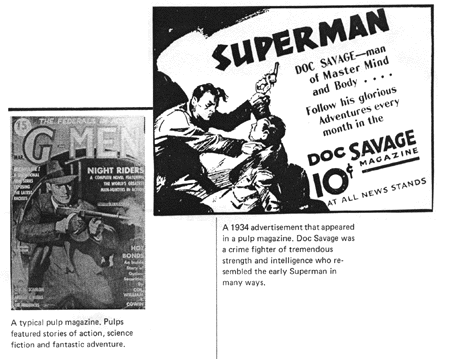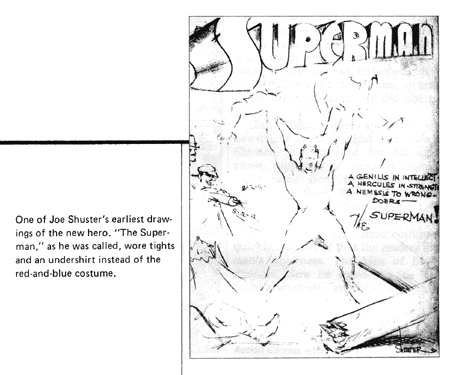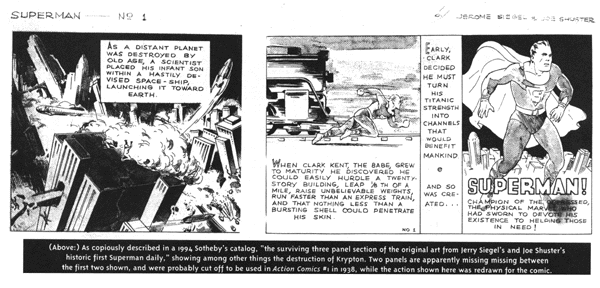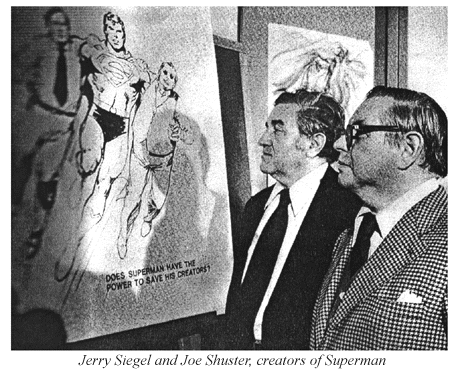Almost everyone knows Superman, fighter for truth, justice and the American way. What most people do not know is that the Man of Steel was not born on the planet Krypton. He was born in Cleveland, Ohio, and his "parents" were two schoolboys.
Jerry Siegel and Joe Shuster were high school kids in Cleveland in 1933, at the worst part of the Great Depression. These were dark times for America. Money was scarce, millions were out of work, and despairing families waited in lines for bread and soup. If ever the country needed a hero, this was the time. One night, just such a hero—Superman—came to life in Jerry Siegel's mind.
Both Siegel and Shuster were rather ordinary kids who were shy and often bullied. They made up for this by living lives rich in fantasy. The boys were fans of science-fiction, which was still new in the 1930s. They listened to adventure stories on the radio and read the thrilling tales in the pulp magazines. The "pulps" were thick monthly magazines of short stories, and usually, one long story featuring a daring hero like Doc Savage, the Shadow, or Operator 5. The magazines got their name from the cheap pulp paper on which they were printed. The pulps were a kind of forerunner to comic books, which in 1933 had not yet been invented.

The idea of Superman came to Jerry Siegel one night just before he fell asleep. All the stories and science-fiction adventures he had read seemed to come together in his head, and out of it all came the notion of a powerful champion of the downtrodden, who could bend the strongest steel and laugh at bullets. Siegel spent most of the night scribbling down the first Superman story. The next morning, he showed the story to his friend Shuster, who was an aspiring artist. Shuster was caught up in Siegel's excitement and designed Superman's costume. The first Superman story, written by Siegel and illustrated by Shuster, appeared in a mimeographed science-fiction magazine put out by the pair.

Siegel and Shuster were convinced their creation was for bigger things than fan magazines. They decided to try for the "big time" by submitting Superman to the companies that produced newspaper comic strips. Time after time their strip was rejected. Some editors said the strip was crude and amateurish. Others said the character was stupid and totally unbelievable. All agreed that the public would never be interested in Superman.
For six years the pair kept at it, but still nobody wanted Superman. During those years, though, the comic book came into being. At first comic books were reprintings of popular newspaper strips, but after awhile, new material began to appear. Comic book publishers wanted to produce the new magazines as cheaply as possible, and since child labor has always been cheap labor, many teen-agers found themselves working in the new medium. Among these were Jerry Siegel and Joe Shuster. The pair produced such strips as "Dr. Occult" and "Slam Bradley." Most of their work appeared in Detective Comics, a title which is still being published today.

One day Siegel and Shuster heard that the editor of Detective Comics was looking for an action series to kick off his new magazine, Action Comics. Eagerly, they presented Superman to the editor. The editor took one long look at the cover drawing, showing Superman lifting a car above his head, and said, "Nobody's going to believe this!" Still, something about the character appealed to the editor, and Siegel and Shuster were offered $130 for all rights to Superman, forever.
At that time, $130 was a lot of money, when a loaf of bread cost 15 cents and the movies a dime. The boys were thrilled when they signed the contract but they would regret this decision for the rest of their lives.
Superman was an instant success. The first issues of Action sold out. Something about the character appealed to everybody, and the public began clamoring for more, more, and still more. Superman got a magazine all his own, then a radio series, an animated cartoon series, newspaper strip, and a movie serial. Siegel and Shuster had to hire assistants to keep up with the work load. The comics company, now called DC Comics, was making millions.
Siegel and Shuster realized they had sold the rights to a gold mine. Time and again they sued the comics company, demanding a cut of the growing Superman empire. Several times they did get more money; by 1940 one magazine reported they were making $75,000 a year. But they never received the percentage they wanted. Then World War II called Jerry Siegel to battle. After the war Siegel returned to DC. He wrote Superman on and off for some twenty years thereafter, under the condition that he deny his role in the creation of Superman. During the "off" periods he battled DC unsuccessfully in court.By the late 1960s Siegel and Shuster faded into obscurity. Siegel had tried to create other characters. He had some success with Superboy, but basically he was a one-idea man. All his other creations flopped. Shuster did work for several comics companies until his eyesight began to fail, and he had to retire. Superman rolled on, becoming a TV series in 1951 and finding huge audiences throughout the world. In 1965, the Man of Steel appeared in a Broadway play called It's a Bird It's a Plane It's Superman. Everyone knew Superman, but nobody remembered Siegel and Shuster.

Then, in 1973, came the news that Superman was going to appear in a big feature movie. The producer paid DC Comics $3 million for the right to make the film. Jerry Siegel, now old and broke, saw one more chance to make something off his old character. This time instead of going to the courts, he went to the newspapers and television. He told a story of how he and Joe Shuster had been destroyed by DC Comics, saying that Superman, the American dream, had brought them an "American nightmare." The American public, with its classic love for the underdog, took the story to its heart. Soon Siegel's and Shuster's names appeared in newspapers around the country. The people at DC Comics were worried. Even though they legally owed Siegel and Shuster nothing, they knew the growing bad publicity could spell disaster for the super-expensive (and hopefully super-profitable) Superman movie. The company responded to public pressure.
Just before Christmas of 1975, DC Comics and Siegel and Shuster reached a financial agreement. Also their names, long absent from the comic pages, appeared as the creators of Superman, the world's first and mightiest superhero. With fame undimmed, the Man of Steel flew into the 1970s.